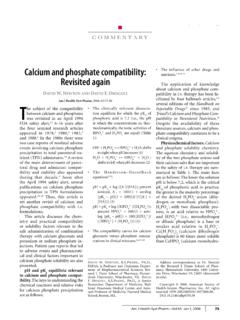Transcription of Calcium and phosphate compatibility: • The influence of ...
1 COMMENTARy Calcium and phosphates73Am J Health-Syst Pharm Vol 65 Jan 1, 2008 COMMENTARyCalcium and phosphate compatibility: Revisited againDa v iD W. Ne Wt oN a N D Da v iD F. Dr i s c o l lAm J Health-Syst Pharm. 2008; 65:73-80Da v iD W. Ne Wt oN, a r m., , FaPha, is Professor and Chairman, Depart-ment of Biopharmaceutical Sciences, Ber-nard J. Dunn School of Pharmacy, Shenan-doah University, Winchester, VA. Da v iD F. Dr iS c o l l, a r m., , is Senior Researcher, Department of Medicine, Beth Israel Deaconess Medical Center, and Assis-tant Professor of Medicine, Harvard Medical School, Boston, correspondence to Dr.
2 Newton at the Bernard J. Dunn School of Phar-macy, Shenandoah University, 1460 Univer-sity Drive, Winchester, VA 22601 2008, American Society of Health-System Pharmacists, Inc. All rights reserved. 1079-2082/08/0101-0073$ subject of the compatibility between Calcium and phosphates was revisited in an April 1994 FDA safety alert,1,2 6 16 years after the four seminal research articles appeared in 1978,3 1980,4 1982,5 and In the 1980s there were two case reports of nonfatal adverse events involving Calcium phosphate precipitation in total parenteral nu-trient (TPN) ,8 A review of the main determinants of paren-teral drug and admixture compat-ibility and stability also appeared during that Soon after the April 1994 safety alert, several publications on Calcium phosphate precipitation in TPN formulations Thus, this article is yet another revisit of Calcium and phosphate compatibility with article discusses the chem-istry and practical compatibility or solubility factors relevant to the safe administration of combination therapy with Calcium gluconate and potassium or sodium phosphate in-jections.
3 Patient case reports that led to adverse events and pharmaceuti-cal and clinical factors important to Calcium phosphate solubility are also and pKa equilibria relevant to Calcium and phosphate compat-ibility. The keys to understanding the chemical reactions and relative risks for Calcium phosphate precipitation are as follows: The clinically relevant dissocia-tion equilibria for which the pKa2 of phosphoric acid is ( , the pH at which the concentrations or, ther-modynamically, the ionic activities of HPO42 and H2PO4 are equal) (Table 1): OH + H2PO4 HPO42 + H2O; shifts to right when pH increases (1) H2O + H2PO4 HPO42 + H3O+; shifts to left when pH decreases (2) T h e H e n d e r s o n H a s s e l b a c h equations9,19: pH = pKa + log ([A ]/[HA]).
4 Percent ionized, A , = 100/(1 + antilog [pKa pH]) = 100{[A ]/([A ] + [HA])} (3)pH = pKa + log ([HPO42 ]/[H2PO4 ]); percent HPO42 = 100/(1 + anti-log [pKa pH]) = 100{[HPO42 ]/([HPO42 ] + [H2PO4 ])} (4) The compatibility curves for Calcium gluconate versus phosphate concen-trations in clinical ,5,17,18 The influence of other drugs and ,10-18 The application of knowledge about Calcium and phosphate com-patibility in therapy has been fa-cilitated by four hallmark articles,3-6 several editions of the Handbook on Injectable Drugs17 since 1983, and Trissel s Calcium and phosphate Com-patibility in Parenteral Despite the availability of these literature sources, Calcium and phos-phate compatibility continues to be a clinical factors.
5 Calcium and phosphate solubility chemistry. The aqueous chemistry and solubil-ity of the two phosphate anions and their Calcium salts that are important to the safety of therapy are sum-marized in Table 1. The main facts are as follows: The lower the solution pH is below , which is the critical pKa2 of phosphoric acid in practice, the greater is the majority percentage of the desired H2PO4 anion (dihy-drogen or monobasic phosphate ). H2PO4 , with two dissociable pro-tons, is an acid relative to HPO42 , and HPO42 ( , monohydrogen or dibasic phosphate ) is a base or weaker acid relative to H2PO4.
6 Ca[H2PO4]2 ( Calcium dihydrogen phosphate ) is 60 times more soluble than CaHPO4 ( Calcium monohydro-COMMENTARy Calcium and phosphates74Am J Health-Syst Pharm Vol 65 Jan 1, 2008gen phosphate ), because CaHPO4 is less ,20 Note that, typi-cal of most divalent cation divalent anion salts, CaHPO4 is minimally dissociated into its constituent ions. Consequently, most of the Ca2+ and HPO42 ions cannot be solvated by dipolar water molecules via ion dipole intermolecular forces, result-ing in solubility in water. Ion dipole forces generally result in greater solubility in water than do other types of solute water inter-molecular ,20 The contrasting high solubility of the divalent cation divalent anion, magnesium sulfate, at more than 500 mg/mL, results from dipole dipole forces between water and the mostly nondissociated MgSO4 ion pairs, which are dipoles.
7 The efficient water solubility of some nonionic organic compounds ( , sugars) results from accepting and donating multiple intermolecular hydrogen bonds with water ( , one hydrogen bond for at least every four carbon atoms).20 The percentages of H2PO4 and HPO42 decrease and increase, re-spectively, by to for each pH unit increase over the pH range of Because 1 meq of HPO42 corresponds to 2 meq of H2PO4 , phosphate concentration should be expressed in millimoles per liter, not in milliequivalents per liter. In the article by Schuetz and King,3 phosphates were reported in milliequivalents per liter but without specific concentrations of H2PO4 and HPO42.
8 The appendix shows the calculation for milliequivalents of potassium and for millimoles of phos-phates per milliliter in commercial Potassium Phosphates Injection, USP, and for milliequivalents of Calcium per milliliter in commercial 10% Cal-cium Gluconate Injection, USP. Before the transition to the degree began achieving national momentum in the 1970s, most pharmacy schools required courses in qualitative and quantita-tive chemical analysis and inorganic pharmaceutical chemistry. Those courses were particularly pertinent to the solubility of Calcium salts, as illustrated by the following excerpt from a monograph on CaHPO4 in a standard pharmacy textbook from 1967: Because this salt is al-most insoluble in water, its chemi-cal reactions are few and relatively unimportant.
9 It is soluble in diluted hydrochloric acid. 19 That CaHPO4 is more soluble at increasingly acidic pH represents the leftward shift in equation 2, and the unimportance of CaHPO4 reactions stated in the 1967 source ended in 1968 with the report that launched TPN,21 which made reactions between Calcium and phosphates in formulations a matter of life and death. Calcium and phosphate solubility for therapy. It is unlikely that any patient-specific admixture con-taining Calcium and phosphates will exactly duplicate the compatibility results of published studies. Three common variables are (1) practition-er and device volume-measurement accuracy and precision, (2) content and pH ranges from The United States Pharmacopeia and The Na-tional Formulary (USP) for Calcium gluconate injection ( , 95 105% of labeled content and pH ) and for potassium and sodium phosphate injections ( , 95 105% of labeled content),22 and (3) other drugs and nutrients that may be included in admixtures ( , the variable compo-sition of TPN formulations, which are often patient specific).
10 Even small differences in the USP-allowed percent content ranges of Calcium gluconate and potassium or sodium phosphate injections may contribute to the precipitation or nonprecipita-tion of CaHPO4 in clinical main factors that are impor-tant to ensuring total solubility or compatibility of Calcium and phos-phates in TPN and other therapy are as follows1-18: The mixture should be agitated to achieve homogeneity after each ingre-dient is added. Potassium or sodium phosphate injection should be added early, and Calcium gluconate injection should be added last or nearly last to the most dilute phosphate concentration ,2,17,18 A air-eliminating sterile inline filter should be used for non-fat-emulsion-containing admix-tures, and a filter should be used for fat-emulsion-containing ,10,13,14,17,18 Table and Water Solubility of Phosphates and Calcium PhosphatesIon or SaltaNamesSolubility (mg/mL)


